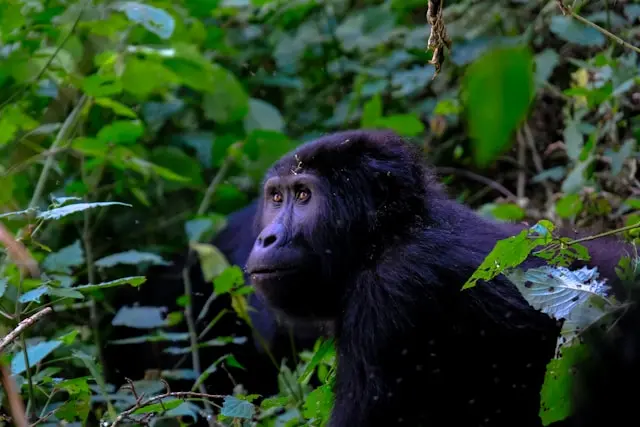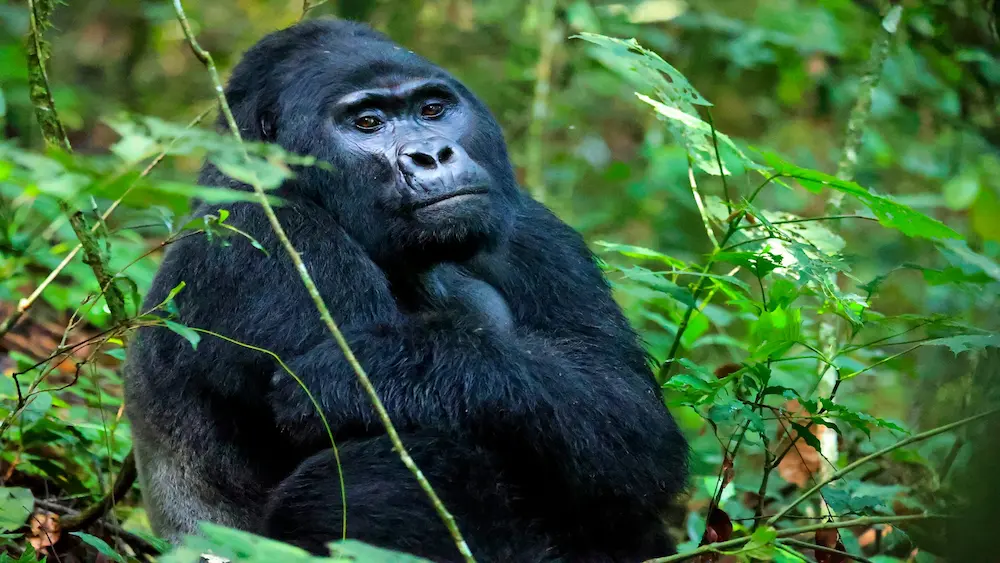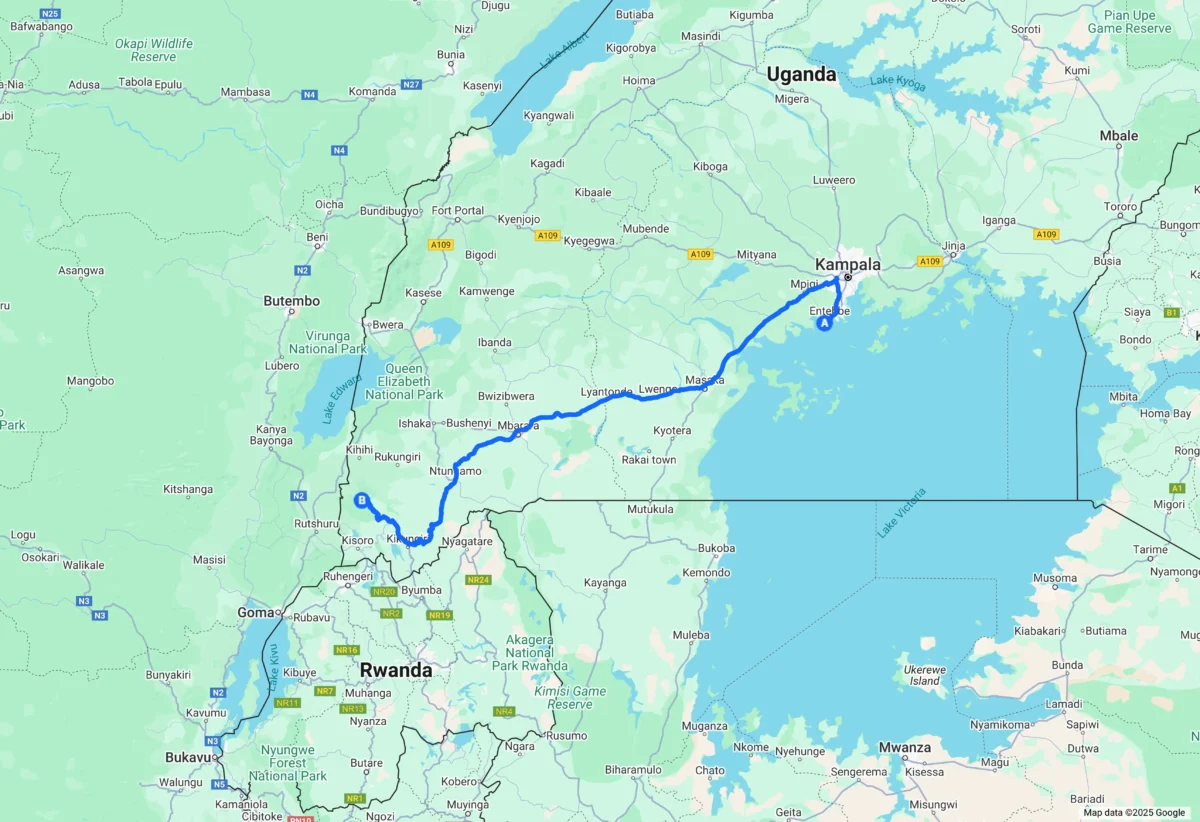
Overview
Bwindi Impenetrable National Park is one of Africa’s most famous wildlife location and is recognised as a haven for endangered mountain gorillas worldwide. Located in southwestern Uganda, it is home to nearly half of the world’s remaining mountain gorillas. This UNESCO World Heritage Site is famous for its dense forests, rich biodiversity, breathtaking landscapes making it a must-visit destination for nature lovers and adventure seekers.
Spanning over 321 square kilometers, Bwindi is located with in the Albertin Rift with its landscape varying in altitude from 1,160 to 2,607 meters above sea level making it a hotspot for ecotourism, attracting thousands of visitors each year. This park offers a once-in-a-lifetime experience, whether your goals are to explore lush rainforests, experience the excitement of gorilla trekking, or become fully immersed in the local culture.

History and Significance of the Park
Bwindi Impenetrable National Park was officially designated as a national park in 1991 to protect the endangered mountain gorillas and their fragile ecosystem. Before this, the region was home to indigenous Batwa pygmies, who lived in harmony with the forest for centuries.
In 1994, the park was declared a UNESCO World Heritage Site due to its exceptional biodiversity and critical role in conserving mountain gorillas. Today, Bwindi stands as a global conservation success story, balancing tourism, research, and wildlife protection.
Mountain Gorillas
Nearly half of the world’s total count of endangered mountain gorillas (Gorilla beringei beringei) is found only in Bwindi Impenetrable national park, Uganda. This makes Bwindi park a must-visit place to watch these great giants in their natural santuary where the park habituated them into 20 groups for a seamless gorilla trekking experience. Each sector of the four Bwindi sectors: Ruhija, Rushaga, Buhoma, and Nkuringo offers unique opportunities for gorilla trekkers making Bwindi the best place to see gorillas in Africa and in the whole world.
Why Visit Bwindi Impenetrable National Park?
- World-Class Gorilla Trekking: Bwindi Impenetrable national park offers the best chance to see mountain gorillas in the wild simoly because it hosts nearly a half of the world’s mountain gorillas.
- Rich Biodiversity: Over 350 bird species, 120 mammals, and countless insects and reptiles make it one of the most biodiverse forests.
- Cultural Experiences: Interact with the indigenous Batwa people and learn about their forest life.
- Eco-Tourism: Your visit supports conservation efforts and local communities, ensuring the park’s sustainable future.
What to Expect at Bwindi Impenetrable National Park
- Challenging Hikes: Trekking can be strenuous, but the reward of seeing gorillas is worth the effort.
- Abundant Wildlife: Beyond gorillas, expect to see primates, birds, and rare forest mammals.
- Cool Climate: Bwindi’s high elevation results in cooler temperatures, especially in the morning and evening.
- Cultural Immersion: Get to know the forest’s history through the Batwa cultural tour.
Geography and Climate
Bwindi Impenetrable National Park sits at an altitude ranging from 1,160 to 2,607 meters above sea level. It features rugged terrain, steep valleys, and thick forests, making it one of the most challenging yet rewarding trekking destinations.
Climate
- Temperature: The park has a cool climate, with temperatures ranging between 7°C (45°F) at night and 20°C (68°F) during the day.
- Rainfall: Bwindi receives high rainfall throughout the year, with March to May and September to November being the wettest months.
- Best Time to Visit: June to August and December to February offer the best trekking conditions due to drier trails.
Wildlife and Biodiversity in Bwindi
Bwindi is not just about mountain gorillas—it’s a biodiversity hotspot with over: 120 mammal species, 350 bird species, 200 butterfly species, 1000+ plant species.
- Mammal species(Around 120): Bwindi offers a wide range of wildlife encounters beyond just the incredible mountain gorillas. It shelters around 120 mammal species that include forest elephants, chimpanzees, duikers, golden cats, and several monkey species like the energetic blue monkeys and black-and-white colobus monkeys.
- Bird species(Around 350): Bwindi also offers a nice opportunity to bird watching enthusiasts with approximately 350 species which include: rare african green braodbill making it a paradise for bird watchers and gorilla trekkers.
- 200 butterfly species fluttering through the dense foliage.
- 1,000+ plant species, including rare orchids and towering mahoganies.
The park’s dense jungle provides a sanctuary for some of the rarest and most endangered species on Earth, reinforcing its importance in global conservation.
Gorilla Trekking in Bwindi National park Uganda
Gorilla trekking is the highlight of Bwindi and one of Africa’s most sought-after wildlife experiences. Like no other in Africa even in the world, Bwindi offers a completly unique opportunity to watch the endangered mountain gorillas face-to-face in their natural habitat. Visitors embark on guided treks through the dense forest to observe these majestic primates. For unforgettable gorilla trekking experiences, one requires a carefully planned trip by a well established company like Kuzora Safari Tours Ltd especially for fist-time trekkers who require well guided treks.
Gorill Trekking Experience-What to Expect During a Trek
- Duration and Difficulty: Gorilla treks can last from 2 to 8 hours, depending on the location of the gorillas and the terrain in the dense forest however, the time spent is always worth it especially when you finally spot these incredible giants. It is always advisable to prepare for challenging conditions especially during the rainy season when trails could be slippery.
- Approach: Trekkers are briefed from the start and grouped into groups of maximum 8 people per trek to minimize disturbance.
- Time with Gorillas: Trekkers are granted one magical hour with the gorillas once found and usually 4 hours for those on a habituation Experience. This is your moment to capture these creatures on your cameras (without) flash of just simply enjoying their presence as you watch them live their lives.
- Conservation: Armed rangers and guides accompony each group providing detailed information about gorilla behavior and conservation.
Physical Fitness Requirement for gorilla trekking
Gorilla trekking requires moderate to high fitness levels due to the park’s rugged terrain esoecially during the rainy season. It’s essential to prepare with proper hiking gear and physical conditioning before the trip.
Gorilla Families/Groups in Bwindi

Bwindi shelters 20 habituated gorilla families each with unique social structures spread across the four sectors. Some popular families include:
- Mubare Group – The oldest habituated family, ideal for first-time visitors.
- Rushegura Group – Known for its playful juveniles and relaxed silverback.
- Habinyanja Group – A large and adventurous family, perfect for photographers.
Each trek leads to a different family, offering visitors diverse experiences.
Best Time to Visit Bwindi Impenetrable National Park
While Bwindi is open year-round, the best time for gorilla trekking is during the dry seasons (June to August and December to February). These months offer:
- Easier trekking conditions: The trails are usually drier in the dry seasons offering a better trekking experience.
- Better wildlife viewing, as animals gather around water sources.
- Ideal photography conditions: This is due to the dry seasons to clearer skies better for photography.
Wet seasons (March-May and September-November) are ideal for bird watching enthusiasts and offer lush scenery but pose challenges like muddy trails and challenging hikes.
How to Get to Bwindi Impenetrable National Park

Bwindi can be accessed via road or air. This journey to Bwindi is an adventure in itself regardless of your choice of transportation.
By Road – The most common way of getting to Bwindi
- From Kampala: A 9-10 hour drive via Mbarara and Kabale towns.
- From Kigali, Rwanda: A 4-5 hour drive, ideal for those combining Uganda and Rwanda tours.
- Usually preferred by people who are more adventurous and interested in experiencing the everyday activities of Ugandans and Rwandans along the road.
By Air – The quickest way to Bwindi National Park
- Flight duration: Approximately 1 hour from Entebbe International Airport or Kajjansi Airfield
- Domestic flights from Entebbe International Airport to Kihihi or Kisoro airstrips, followed by a short drive to the park. Domestic flights are always available and they can be taken from Entebbe International Airport or Kajjansi airfield in Kampala to the above mentioned airstrips near Bwindi.
- Typically preferred by individuals who come on luxury trips and do not want to spend much time traveling by road.
Private transfers and safari packages make the journey smoother for tourists. Trusting well established companies like Kuzora Safari Tours to arrange transportation and logistics can ensure a stress-free and seamless travel experience.
Accommodation Options in Bwindi
Bwindi impenetrable national park offers a variety of accommodations, ranging from luxury lodges to budget-friendly campsites.
Luxury Lodges
- Sanctuary Gorilla Forest Camp – An exclusive lodge inside the park.
- Clouds Mountain Gorilla Lodge – Offers stunning views and top-tier service.
Mid-Range Lodges
- Buhoma Lodge – Cozy accommodations with great access to gorilla trekking.
- Nkuringo Bwindi Gorilla Lodge – Perfect for adventure travelers.
Budget Options
- Bwindi Backpackers Lodge – Affordable yet comfortable.
- Broadbill Forest Camp – Ideal for budget-conscious nature lovers.
Other Activities in Bwindi
While gorilla trekking is the main attraction, Bwindi Impenetrable National Park offers several other activities for nature lovers and adventure seekers.
Bird Watching
Bwindi national park is a birder’s paradise, home to over 350 bird species, including 23 Albertine Rift endemics. Some of the must-see species for Birwatching enthusiasts include:
- African Green Broadbill
- Shelley’s Crimsonwing
- Handsome Francolin
- Rwenzori Night jar
Guided bird-watching tours take visitors deep into the forest, where they can spot rare species in their natural habitat.
Forest Walks and Hiking Trails
For those who love hiking, Bwindi impenetrable national park offers scenic trails such as:
- Munyaga River Trail – (45 Minutes, Suitable for hikers of all abilities) This trail is located in Buhoma sector outside the park. It is a short and easy to walk trail ideal for spotting monkeys, waterfalls and birdwatching.
- Mubwindi Swamp Trail – (4 -5 hours, Suitable for most fitness levels). This one is located in the Ruhija sector offering wild life and mountain gorilla encounters and usually takes upto 7 hours to complete.
- Kashasha River trail – (5 hours, most challenging but rewarding) This one connects nothern Buhoma sector to southern Nkuringo sector and it can take upto 7 hours to complete however it offers high chances of encountering wildlife and mountain gorillas.
- Ivy River Trail – A 14km trail offering panoramic views of the forest.
- Rushura Hill Trail – A viewpoint offering sights of the Virunga Volcanoes and Rwenzori Mountains.
Primate Viewing
Apart from gorillas, the park is home to other primates like black-and-white colobus monkeys, L’Hoest’s monkeys, and baboons. Over 200 butterfly species also flutter through the forest, adding to the park’s magical ambiance.
Cultural Encounters with the Batwa People
Before Bwindi became a national park, the indigenous Batwa pygmies lived in harmony with the forest. Today, visitors can participate in Batwa cultural experiences, which include:
- Traditional Dances and Music: Witness energetic performances showcasing Batwa heritage.
- Storytelling Sessions: Learn about their ancient way of life through folklore.
- Hunting and Gathering Demonstrations: Experience their traditional survival skills.
This cultural interaction provides an enriching experience while supporting the Batwa community through tourism revenue.
Conservation Efforts and Challenges
Bwindi impenetrable national park plays a crucial role in the conservation of endangered mountain gorillas. Several organizations and government initiatives work together to ensure their protection.
Conservation Initiatives
- Gorilla Habituation Programs: These allow researchers and tourists to spend extended periods with gorilla families, helping in their conservation.
- Community-Based Tourism: Local communities benefit from tourism revenue, reducing the pressure on forest resources.
- Anti-Poaching Measures: Park rangers actively patrol the forest to combat illegal activities like poaching and deforestation.
Challenges
Despite conservation success, the park faces challenges such as:
- Human-Wildlife Conflict: As human settlements expand, encounters between wildlife and locals increase.
- Illegal Activities: Poaching and deforestation still pose threats to the park’s ecosystem.
- Disease Transmission: Gorillas share 98% of their DNA with humans, making them susceptible to human diseases.
Visitors are required to follow strict health guidelines to prevent disease transmission to the gorillas.
Tips for gorilla trekking
A successful trip to Bwindi requires careful planning. Here are some essential tips:
General Tips
- Book Your Gorilla Trekking Permit Early: With out the permit you can not trek, therefore, the very first tip is to make sure that you secure your permit earlier as they usually sell out earlier especially in peak seasons.
- Train for Trekking/Physical fitness: As you get closer to your trekking experience, fitness training can help prepare for the challenging terrain.
- Respect Wildlife and Guidelines: Follow park rules to ensure both your safety and that of the gorillas.
- Engage a Local Guide: Local guides provide valuable insights and enhance the trekking experience.
Gear/Packing list for gorilla trekking
- Hiking boots – Sturdy, waterproof boots for navigating muddy trails.
- Long-sleeved shirts and pants – Protects against scratches and insect bites.
- Rain jacket – Essential due to unpredictable rainfall.
- Insect repellent – Protects against mosquitoes and other insects.
- Camera with extra batteries – Capture unforgettable moments.
- Gloves – Helps with gripping vegetation while trekking.
- Water bottle and snacks – Stay hydrated and energized during long hikes.
Gorilla Trekking Permits and Costs in Bwindi
Gorilla trekking permits are essential for visitors and contribute to conservation efforts. It is important to note that Uganda Wildlife Authority limits the number of permits issued daily to reduce the impact on gorillas and maintain a quality experience. The permit fee covers the thrilling one-hour gorilla trekking session, park entry and a ranger guide.
Gorilla trekking Permit Costs in Uganda(2025):
- Foreign Non-Residents: $800 per person
- Foreign Residents: $700 per person
- East African Citizens: UGX 250,000 per person.
Additional Costs
- Accommodation: $50 – $1000 per night, depending on the choice of lodge, whether budget, mid-range, or luxury.
- Transport: Flights from Entebbe to Bwindi cost around $300-$400, while road transport costs vary based on group size and vehicle type.
- Guide and Porter Fees: Hiring a porter ($15-$20) is highly recommended for carrying backpacks and providing assistance.
You can purchase these gorilla trekking permits from the Uganda Wildlife Authority through a licensed tour operator and it is always wise to book your gorilla pemit in advance especially in peak seasons as they usually sell out months ahead of time.
Booking with a reputable licensed tour operator like Kuzora Safari Tours simplifies the process and provides a flawless experience. Booking an all-inclusive gorilla trekking package that covers accommodation, meals, transportation, and adventure activities saves you a significant amount of time and lets focus on your adventure. Kuzora Safari Tours can help you organize your dream safari to Bwindi by offering personalized itineraries, hotel recommendations, and insights to ensure a wonderful trip.
Final Thoughts
Bwindi Impenetrable National Park is more than just a wildlife destination—it’s a place of wonder, conservation, and adventure. Whether you’re fulfilling a lifelong dream of seeing gorillas up close, hiking through breathtaking landscapes, or engaging with the rich culture of the Batwa people, Bwindi offers an unparalleled experience.
By visiting this remarkable park, you not only witness nature at its best but also contribute to the conservation of one of the world’s most endangered species. Start planning your gorilla trekking trip today with kuzora safari tours and embark on an unforgettable journey into Uganda’s wild heart.
FAQs
1. How difficult is gorilla trekking in Bwindi?
Gorilla trekking can be challenging due to steep, muddy trails, but it is manageable for most people with moderate fitness levels. Hiring a porter can help ease the experience.
2. What are the chances of seeing gorillas in Bwindi?
The chances of seeing gorillas are over 95%, as expert trackers monitor their movements daily.
3. Can children participate in gorilla trekking?
Children under 15 years are not allowed to trek gorillas for safety and conservation reasons.
4. What should I wear for gorilla trekking?
Wear long-sleeved clothing, hiking boots, a rain jacket, and gloves to protect against rough terrain, insects, and changing weather conditions.
5. Are there any health requirements for gorilla trekking?
Visitors must be in good health. If you have a cold, flu, or any contagious illness, you may be denied trekking to protect the gorillas from human diseases.

